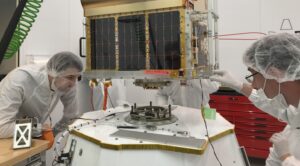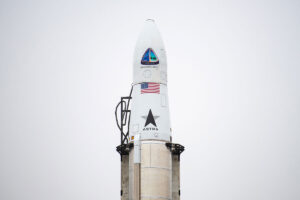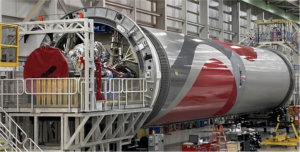
Starliner Is Weeks Away From Its First Crewed Launch!
Boeing and NASA just held a briefing yesterday and it looks like Starliner is finally set to launch crew, and in only a few weeks. The program so far has been far from smooth with budget problems, delays, in-flight anomalies, etc. All of which have pushed back this maiden flight that originally was supposed to happen around 7 years ago. This however is set to change with a launch date scheduled for early May.
For the past few months the company, alongside NASA have been working on a few issues that came up related to flammable tape used inside the spacecraft and its parachute safety margin. By now, they are confident these past concerns are now fixed and are just about ready to liftoff. Here I will go more in-depth into the recent briefing, the significance of this launch, what to expect in the next few weeks, and more.
Launch Ready

Yesterday on the 22nd, during the briefing, we learned more about the state of the vehicle and its upcoming launch. So far Starliner has flown two missions, OFT-1 and OFT-2, both uncrewed test flights. The first failed to reach the ISS requiring the second which had a few issues but was considered a success. This upcoming mission however will send NASA astronauts Butch Wilmore and Suni Williams to the ISS. Here they will stay on the station for about eight days before returning to land.
In regard to the mission, officials said that preparations for the Crew Flight Test (CFT) mission are proceeding well, and that the launch is scheduled for no earlier than May 1. This specific date has less to do with the readiness of Starliner and more so with how busy the ISS is. The station has a full manifest of incoming vehicles which ended up delaying Starliner’s upcoming launch from late April to early May. Mark Nappi, Boeing’s vice president and Starliner program manager even said that the spacecraft and its United Launch Alliance Atlas V rocket could roll to the launch pad at Space Launch Complex-41 at Cape Canaveral Space Force Station in Florida as soon as April 10. In other words, Starliner and its two-person crew are ready to fly.
Focusing more on the vehicle, they mentioned NASA was still wrapping up a few certification items for the crewed flight test, including looking at data from the recent parachute test related to the soft links issue. Despite this, he said, “We’re in really good shape.” In addition, Mark Nappi commented, “We have primarily been working on getting the vehicle of course ready for flight and solving the two issues that we had back in the summer, which were the parachute system and the tape flammability issue that we had. We can safely say those issues are behind us.”
Only days ago, the company began fueling the spacecraft. Specifically, they pointed out that Spacecraft fueling had begun for the upcoming Crew Flight Test. The Starliner spacecraft, consisting of a reusable crew module and expendable service module, was recently moved into the Hazardous Processing Area at Boeing’s Commercial Crew and Cargo Processing Facility (C3PF) at Kennedy Space Center in Florida. This fueling process is supposed to take a little more than two weeks.
In this case, conducting the propellant loading operation is a team made up of specially trained technicians, as well as fluids, propellant and electrical test engineers. To perform the operation, technicians wear what’s called a SCAPE suit. SCAPE stands for Self-Contained Atmospheric Protective Ensemble and the suit protects them from any hazardous commodities. Throughout the operation, test teammates monitor the spacecraft, including sensors and valves, as well as the environment. Once fueling is complete, final closeout activities will be performed for the spacecraft’s rollout from the factory to United Launch Alliance’s Vertical Integration Facility at Cape Canaveral Space Force Station. Closeout activities include removing propellant access panels, placing environmental covers over the spacecraft’s thrust nozzle outlets, performing thermal protection system work, checking the spacecraft’s final weight and center of gravity, and loading it onto the transport vehicle. All of which we can expect in only a few weeks from now.
Lots of Fixes

It has been almost two years since the last Starliner launch or the OFT-2 mission back on May 19th, 2022. You would think that after a successful test, the turnaround would be reasonable however Boeing had a lot of work to do after the second test flight. For example, during the mission, despite its success, two Orbital Maneuvering and Attitude Control System (OMACS) thrusters failed during the orbital insertion burn. Thankfully, the spacecraft was able to compensate using the remaining OMACS thrusters with the addition of the Reaction Control System (RCS) thrusters. To add to this, a couple of RCS thrusters used to maneuver Starliner also failed during docking due to low chamber pressure. Some thermal systems used to cool the spacecraft also showed extra cold temperatures, requiring engineers to manage it during the docking. Despite these different complications, the spacecraft did dock to the ISS and eventually returned to Earth for a soft landing.
Teams obviously had to address these issues but the company was also in the process of working on the spacecraft used for the first test flight. Interestingly, the Starliner that is about to launch crew is the same one that was used during OFT-1, not OFT-2. Since the original flight, it has been upgraded and altered in certain ways to ensure it’s both safe and capable of a trip to the ISS. As far as the mission profile goes, the CFT has a similar flight profile to the original missions.
In the recent briefing, Nappi highlighted, “The CFT flight is really the introduction of crew into our vehicle systems, so a lot of our flight test objectives are about how that interface will work. It’s all about, does the vehicle perform with the human in the loop as expected” he said. Some of the test objectives range from the performance of the spacecraft’s life support systems to the use of manual controls to operate the spacecraft should automated systems fail. They pointed out that the two pilots, Wilmore and Williams will test the ability to manually control and orient the spacecraft during a day-long flight to the ISS, and test maneuvering during a 6.5-hour trip from the station back to the ground.
In the grand scheme of things, this mission is mainly just a test to certify the vehicle for crew flight. Assuming everything goes according to plan, they expect to complete certification in November or December. This would allow them to carry on with the first official Starliner crewed mission named Starliner 1 sometime in 2025. Instead of a multi-day trip, this mission would have a larger crew and stay docked to the station for months. At that point, NASA would have multiple commercial vehicles available for crew and cargo transportation. “We are really excited on the station side to get this first crewed Boeing Starliner mission up to the space station,” said the NASA ISS deputy program manager. “It’s always been our goal to have a handful of different vehicles that we can fly to get crew up there.”
Originally, Boeing and SpaceX were both tasked by NASA in 2014 to create new commercial crew vehicles, with billions of dollars of funding. Boeing managed to receive $4.2 billion while SpaceX received $2.6 billion in those deals. SpaceX Crew Dragon’s first astronaut flight flew in 2020. In the four years since, the company has sent 11 missions to ISS. This has racked up a significant amount of money for the company in terms of large crew contracts. On the other hand, Boeing’s delays have forced the company to miss out on different opportunities and even lose around $1.5 billion thanks to different charges.
Once the Starliner achieves NASA certification, the initial contract required Boeing to conduct at least two, and as many as six, crewed missions to the space station. In total, Starliner is compatible with Atlas V, Delta IV, Falcon 9, and Vulcan Centaur. By now, the Delta IV is retired and no longer available. In addition, ULA has announced that Atlas V is retiring and all remaining Atlas V launchers have been allocated to customers. As of 2 July 2022, seven of these have been allocated to Starliner flights; enough for the crewed flight test and six operational missions. ULA plans to have Vulcan Centaur available in time for any additional flights. With the recent successful flight of Vulcan, that could end up being the future launch vehicle for Starliner.
Stich recently said, “It’s always tough to fly into space. There are always challenges with every launch vehicle and spacecraft and so for us having that second transportation system is hugely important to us. Bringing along our second human rating vehicle in the period of four years has been a tremendous honor for our commercial crew team and a tremendous challenge of just getting through all the work to get these two spacecraft, Dragon and Starliner, flying” he said.
With so many changes in the timeline related to Starliner, several past Starliner astronauts have been reassigned to other missions. One of those astronauts formerly assigned to Starliner ended up flying to the ISS this month aboard SpaceX Dragon instead. The goal is for Starliner to provide a second option for running astronauts up to the ISS from U.S. soil, alongside SpaceX. Something we could see in the not-so-distant future.
Conclusion
Starliner is on track for a launch in about 6 weeks from now. This has been a very long time coming and will be the first Starliner launch with humans aboard. We will have to wait and see how it progresses and the impact it has on the space industry.



